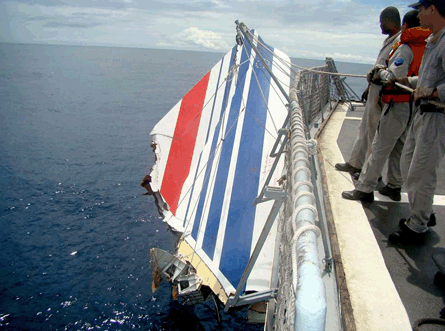Complications with the investigation into the destruction of Air France flight AF447 are set to dominate discussions on flight-data retrieval, aircraft communications and tracking at a high-level ICAO safety conference this month.
The gathering in Montreal comes a few weeks after France's Bureau d'Enquetes et d'Analyses published a technical analysis of several potential options to avoid loss of crucial flight-recorder information in the event of an aircraft accident at sea.
European representatives are to present a paper at the conference highlighting the "exceptional challenge" posed by the loss of AF447, which crashed into the South Atlantic on 1 June last year. Two attempts to find the Airbus A330's flight recorders have failed and preparations are under way for a third.
"Due to the lack of data, the precise circumstances and causes of the accident may remain unknown," says the paper.
It adds that the crash of a Yemenia Airbus A310 off the Comoros Islands in the same month presented similar recovery problems, after locator beacons separated from the flight recorders' memory modules and delayed their recovery by eight days. Owing to damage to the modules another two weeks' work was needed to retrieve data.
In the wake of AF447's loss, BEA created a flight-data recover working group which assessed three areas - flight-data transmission, new flight-recorder technology and improved wreckage-localisation technology - on the basis of technical maturity, cost and current equipage levels. The working group recently published its findings.
Installation of a lightweight recorder in aircraft vertical fins was among the options considered. But while the fin of AF447 was retrieved, tail debris was recovered in only 20% of 26 similar underwater recovery operations studied.
 |
|---|
Deployable, free-floating recorders were also examined but while the analysis accepted development of such devices as credible they are still viewed as a longer-term solution. BEA says deployable recorders could be "difficult to install" on aircraft whose initial design did not account for such modification.
In the medium term an emergency situation could trigger a satcom-equipped aircraft to transmit a package of essential flight data. But the working group says that while related testing has already been carried out for several years, such trigger conditions are "not mature yet by industry standards". Use of ACARS operational communications for regular relay of flight parameters is also seen as a possibility.
BEA has already formally recommended that underwater locator beacons be required to transmit for 90 days, rather than 30, and that aircraft carry a beacon which transmits on a lower frequency of 8.5-9.5kHz rather than 37.5kHz.
The lower frequency would extend the range of transmission from 1nm to 4nm for the same output power, increasing the possibility of detection by military vessels.
Other ideas explored but less favoured included the use of beacons responsive to interrogation, and transmission of full flight-recorder parameters, cockpit-voice audio or cockpit images.
The ICAO conference will also hear from the European delegation that AF447 has shown that "unreliable, non-permanent" air-ground communication and "suboptimal" oceanic surveillance can "adversely impact the timely launching of search and rescue phases, and aircraft wreckage recovery".
It will request that ICAO undertakes a comprehensive review of short- and long-term methods of enhancing oceanic communications and surveillance capabilities, and look at ways of reducing reliability problems with high-frequency radio.
Despite the increasing use of datalink position-reporting in oceanic regions, the delegation will state that progress towards minimum levels of permanent flight-tracking and route-conformance monitoring is "slow", partly as a result of differing regional practices.
Cost of satellite communications "seems to be a deterrent" to aircraft operators, it will add, with data suggesting that only 40% of aircraft in the North Atlantic area are logged-in with air traffic ground systems at any given time: "That may be explained by users' uncertainty that they will secure a sufficient return on their investment, in operational and financial terms, from such applications."
Source: Air Transport Intelligence news
















